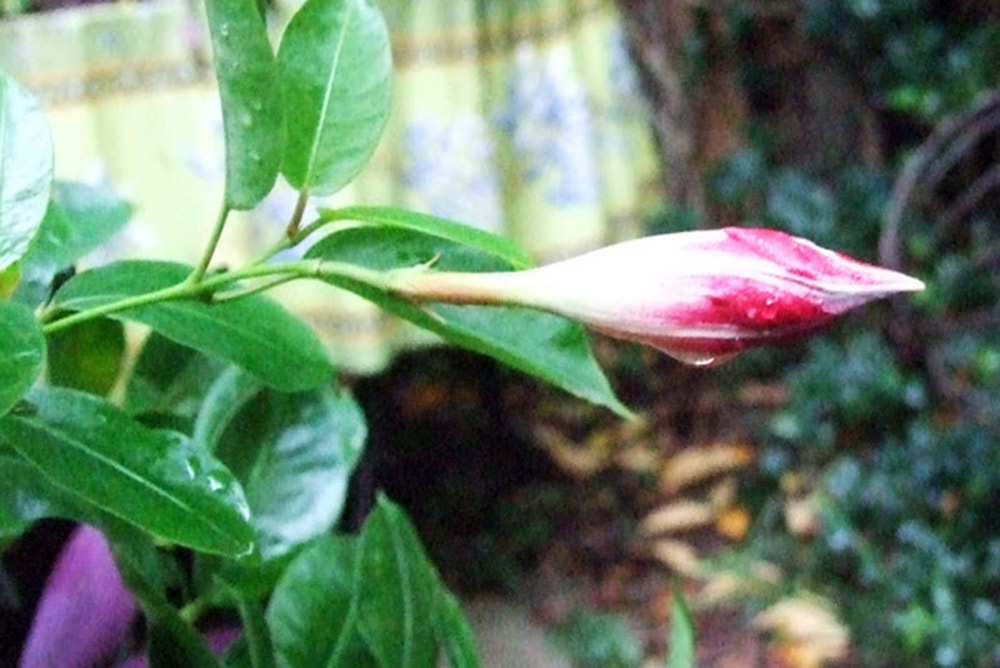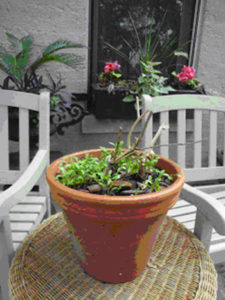
The mandevilla plant in question. So full of promise, so full of disappointment. / Photo by Stephanie Cavanaugh.
WILL THE MANDEVILLA give me one lousy flower this year?
I have been observing the bud for the past week, creeping past last night’s dirty dishes (not my job) each morning and tiptoeing down the steps into the garden, wincing over the pebble path in my socks, hoping that this single bud has finally opened into a flower.
At 7am it was looking a little shriveled, although it appears better in the photo than it has any reason to. An over-caffeinated hand was at hand, giving it a facelift. Like a Vaselined lens focused on a wrinkled face.
This was an apology plant, purchased in early July at our local garden emporium, a small place, just past D.C.’s Southwest Freeway overpass, that’s exceedingly expensive but particularly lush and tempting. The Prince had done Something Bad, I forget what now. And we were out for a bumpy walk that ended up here, with the purchase of this cheery specimen, all red and white stripes, as the photo showed. At $30, it was far more than I would usually spend, particularly for a plant that has repeatedly failed me (though it grows like a weed in every third garden in our Capitol Hill neighborhood).
But I let him buy it for me. Perhaps with a hint of malice, knowing that it would fail. And I’ve watched it grow bushy and green with not one hint of a flower, never mind a bud. Until now, at the season’s tail end, when I’m mentally preparing to up-pot my tropicals and tote them to the second-floor greenhouse—or figure out a way to guilt someone else into the toting—and considering the annual burying of the tulips.
Sadly, mandevillas do no better in the greenhouse than they do in the garden.
Why?
If you think that because I write about gardening that I know what I’m doing, you’re wrong. This month I am celebrating 33 years of generally unsuccessful toiling over the same garden. Pretty much nothing has gone according to plan.
My best work, in fact, has been cultivating friends who know less than I do and so are buffaloed into thinking some strategy was involved in the garden’s evolution from dirt and a clothesline to a jungle.
I mean, I usually start out by reading and studying and developing . . . thoughts. I shall plant this and that and move this here and there . . . and maybe some lighting?
And then I get distracted by a mandevilla, knowing It Will Not Work under the dense canopy of shrubbish I have stuffed into this tiny plot and never get around to pruning. So many flowers are too captivating to ignore. Shiny things, you know. Do you?
Like lilies. For years I attempted them, I had some limited success early on, each year they came up, blossomed and then stood there looking all grim and spindly from late June through September. They did bring about one of my earliest and most successful eurekas of fakery, however. I wired some rather nice silkesque ones to the stems and honestly fooled myself into thinking them real. But even the stems fail on me now, just as well, really—the scent of lilies reminds me of funerals. There was just one bloom on sorry display this year; that was sadder still as Someone managed to knock its support and step on that single flower. May I say, this lily whatever-it’s-called (I always think I’ll remember but don’t) has been taking up precious space for several years, growing taller and leggier every season—but has never been more floriferous, which isn’t saying anything at all.
Then there’s the mallow, the giant-leafed relative of the tropical hibiscus with flowers the size of platters. You see them everywhere, in pocket parks, along highways, untended, growing like weeds. Except around here, where I thought they’d make a splendid display in the big planter near the curb. They didn’t even bother to come up this year, and so we tried . . . angel’s trumpet! Yet another flower of industrious production, poisonous to dogs, but hell—anything for flowers. And just this morning I was enjoying (another) self-congratulatory moment with it before my hike—thinking about the Du Pont garden in Wilmington where angel’s trumpet are trained in pots as standard trees and fantasizing that this is where this sorry (and entirely flowerless) specimen that I’ve been nursing for three summers is headed. Even my cunning underplanting of moonflowers and pink morning glories is struggling. The gods laugh
On the upside, there’s the pink trumpet vine, bought for $30 plus shipping from Plant Delights, an online nursery in North Carolina famous for its terrifically witty catalogue and for employing one of David Sedaris’s sisters for several youthful summers. The catalogue said, “Crinum ‘Pink Trumpet’ is . . . topped with 4′ tall flower spikes from July through September. Each spike terminates in a cluster of 8-10 dark rosy pink, very fragrant, trumpet-shaped flowers.” This I imagined splayed across the front yard, mingling with the ivy, a cheery scented sea of pink flowers.

This is the dead-stick pink trumpet vine. Don’t be fooled: The pink flowers in the picture are in the flower box in the rear window. / Photo by Stephanie Cavanaugh.
Yes, it looks like a bunch of dead sticks (though the cilantro seed I tossed in to remind me not to discard the pot is flourishing. Olé, guacamole). However! No one else in the neighborhood has one, so what you have here is the area’s premier example of a pink trumpet vine. Exquisite, isn’t it?
I think it may be dead.
—Stephanie Cavanaugh
Gardener Cavanaugh is working on a book about city gardening (and anything else she can think of). To read her earlier D.C. Green Acre columns, type Green Acre into the Search box at the top right of the page. We numbered them so you can follow the gardener’s “progress.”
